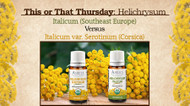This or That: Helichrysum — Italicum vs Italicum Serotinum
Oct 12th 2023
Posted by Dr. Christoph Streicher and Linda J.
Emerging from the land of civilization-shaping myths, where the energy of the sun was associated with the gods, comes a flower that has magical properties that match its name: Helichrysum. Helios Chrysos, or Golden Sun, was loved by the Greeks of antiquity, who knew its powers well. The 3rd century BC philosopher Theophrastus, a contemporary and friend of Aristotle’s, is known as the Father of Botany. A philosopher-scientist, his most famous work, Enquiry into Plants, was the go-to guide on the practical uses of plants up to the Renaissance. His innovative approach to natural history influences the science of Botany to this day. Theophrastus reported using Helichrysum oil mixed with honey to treat wounds and burns.
This small, sun-loving shrub, a member of the Asteraceae (daisy) family, has over 600 varieties. It is native to the Mediterranean, as well as in parts of Asia, Africa, and Madagascar. Helichrysum italicum is the main species, while Helichrysum italicum var. serotinum is a primary variety, and is the most potent among all varieties. Helichrysum positively glows with its tiny, multiple, bright yellow blossoms amidst ghostly pale green leaves. With its luxurious, honey-fruit scent, and skin-healing properties, it will make you glow as well!
What is Helichrysum? Why has it been so important? From Folklore to Modern Science
Well-named as Immortelle, or Everlasting, Helichrysum is a perennial plant with beautiful clusters of sunshine-yellow flowers in late summer. It has a strong smell, similar to curry, and grows well in dry, rocky areas with little water. It has silver-toned, woody stems, and velvety gray-green leaves.
Considered the “sleeping giant” of Mediterranean folk medicine, the Helichrysum herb contains phyto-chemicals that give this plant anti-inflammatory, anti-oxidant, anti-viral, anti-fungal and anti-microbial properties.* Of great interest to many of us is the incredible effect that Helichrysum has in healing and repairing mature and damaged skin.* It also protects the skin from microbes, fades blemishes, and heals minor bruises.*
In some folk medicine traditions, Helichrysum leaves are burned like incense to ease coughs and headaches.* Scientific research has established Helichrysum as an expectorant and mucolytic.* Because mind, body and spirit are all connected, you may find that Helichrysum provides gentle soothing to emotional and psychological wounds as well.*
In addition to Helichrysum’s anti-oxidant and anti-microbial qualities, which makes it an excellent choice for skin care, the National Institute of Health has confirmed that it has a positive effect on post-operative tissue regeneration, as well as on bacterial and viral infections.* The NIH has also found that Helichrysum is useful in inhibiting herpes simplex, and even HIV!*
“I’ve seen a lot of varieties of Helichrysum, but which one should I buy?”
There are hundreds of varieties of Helichrysum. Amrita is proud to offer two types of Organic Helichrysum Essential Oil: Italicum from South Eastern Europe and Serotinum from Corsica. Both are considered the top two varieties for aromatherapy. Let’s take a look at the primary three Helichrysum commonly seen at many aromatherapy stores:
- Helichrysum Italicum (from Southeast Europe):
- This is the most widely available variety of Helichrysum. It grows in Italy, Slovenia, and Albania, and has the remarkable ability heal wounds and relieve pain caused by inflammation.* Italicum contains an RX of many plant compounds, including b-caryophyllene, limonene, rosifoliol and curcumene. These constituents support cell regeneration and wound repair.* In particular, curcumene (also found in Turmeric) has anti-inflammatory and analgesic effects; Helichrysum italicum used topically can reduce pain.*
- Helichrysum Italicum var. Serotinum (from Corsica):
- This variety, grown in Corsica, regenerates cells with amazing effectiveness.* Excellent for fading scars and blemishes, it also soothes emotional wounds, encouraging the process of letting go.* Helichrysum Serotinum has a very high level of the plant compound neryl acetate, which gives it a lovely, floral and herbal aroma and a calming effect, too.* Anecdotally, there are reports of restoring the sense of smell using Helichrysum Serotinum.* Regular application of this oil inside the nostrils, (using a Q-tip and diluted in a carrier oil of course) rejuvenates the cilia inside the nose, thus improving olfactory function.*
- Helichrysum Bracteiferum:
- In Mozambique, tuberculosis patients have found relief by placing dried helichrysum roots on hot coals, then inhaling the smoke beneath a blanket.* Reinforcing this report, scientists have found mucolytic and expectorant properties in Helichrysum Bracteiferum.* With its terpenes of humelene (also found in Sage), this variety supports immune system health.*
What is the difference: Helichrysum Italicum (SE Europe variety) vs. Helichrysum Italicum Serotinum?
Helichrysum Italicum is anti-inflammatory and tissue regenerating.* It is well suited to pain relief and wound healing, while Helichrysum Serotinum is more potent in producing these effects. It reduces the appearance of wrinkles, blemishes, and dark spots.*
Both Italicum and Serotinum contain compounds that protect your face, promoting better collagen and elastin production.* You could use Italicum for daily, preventative maintenance, to heal bruises, or to reduce pain caused by inflammation.* You could deploy Serotinum for key problem areas, and for the overall restoration of more mature skin.* The Serotinum variety has the added benefit of calming your energy.* It can help heal your heart by encouraging the release of painful feelings, repairing emotional scars.*
If you’d like to combine the benefits of both, perhaps keep Italicum on hand for everyday use, and bring out Serotinum for bigger challenges. Or, you could blend them, (see below) and enjoy both preventative / healing and repair / soothing effects together!* All the effects of the Italicum are contained in the Serotinum variety, but it is more pronounced and stronger.
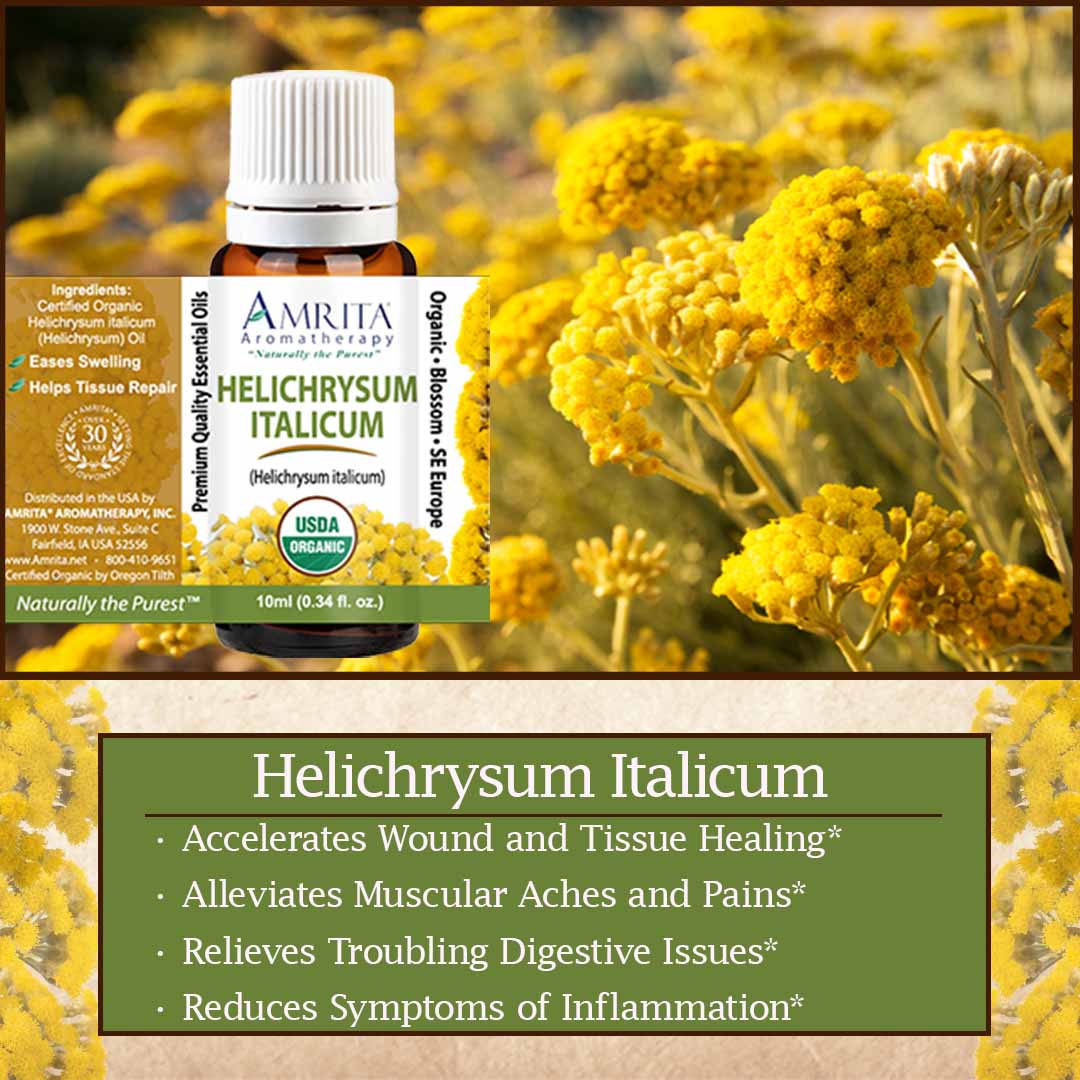 | 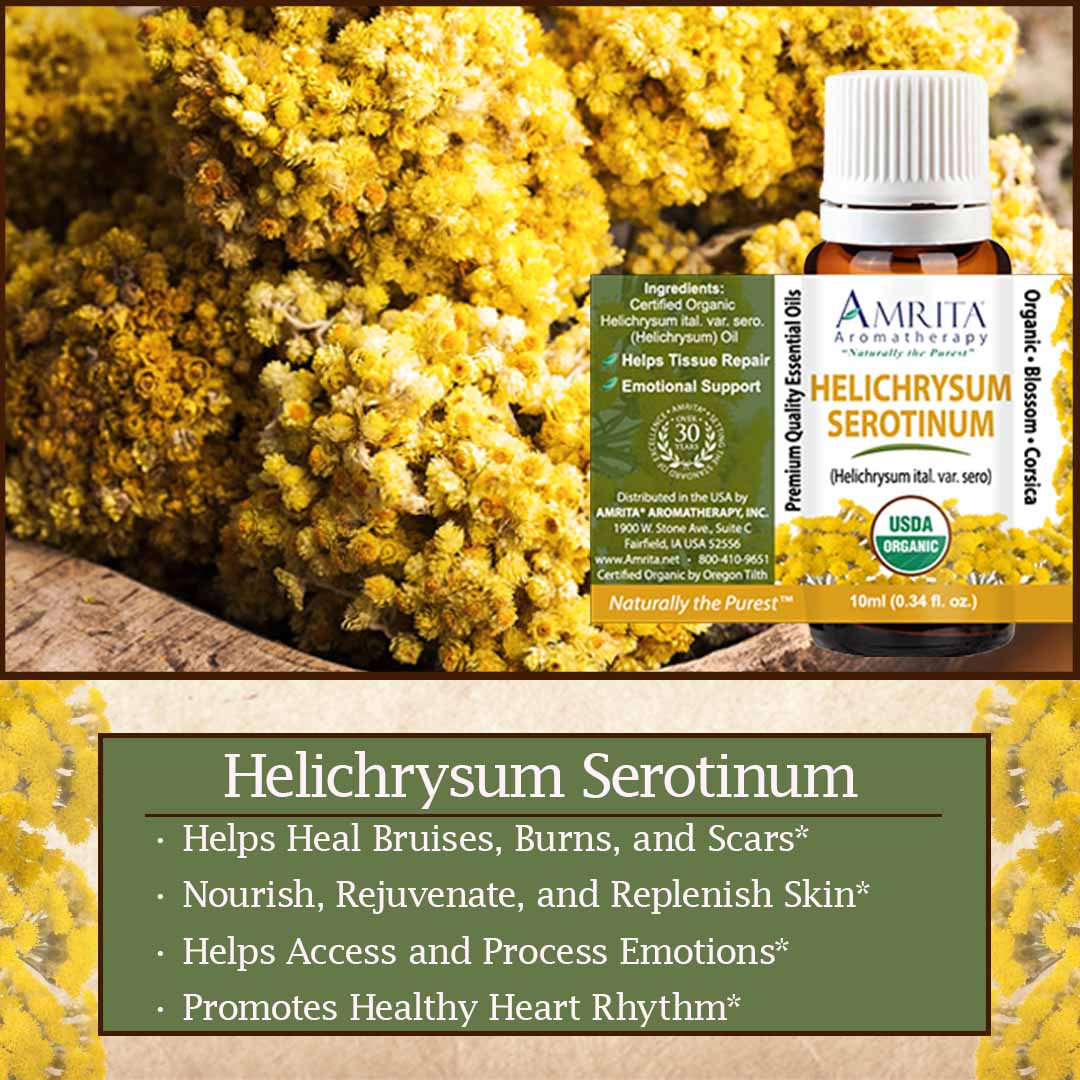 |
How to use Helichrysum
As with any essential oil, it is key that you dilute it properly for topical application. Please follow Amrita’s guidelines below when blending these potent varieties of Helichrysum. This ensures that you receive the maximum healing potential of the plant, and also enjoy the experience!*
- Overall Topical Application: 2-5% dilution
- A popular way to administer both Italicum and Serotinum varieties of Helichrysum is to add them to pure Rosehip or Apricot Kernel oil, then apply the blend to your face or body. This is good for minor repairs, such as for scars or blemishes, or just to give yourself an immortal glow!* This blend also gives a sense of tranquility and lightness of being. For best results, blend 15 drops of Italicum with 10 drops of Serotinum in one ounce of your carrier oil, but please do a skin patch test before applying liberally.*
- Whole Body Massage Application: up to 2% dilution
- What could be more delicious than a whole-body massage designed to bathe your all your cells in Immortelle flowers? Helichrysum is known to help with lymphatic drainage too, aiding in detoxification.* Blend 40 drops Italicum (approx. 1 mL) and 40 drops of Serotinum into a cup (8 oz) of pure Jojoba or Sunflower Oil. Repeat the blend as needed for an extravagant, fountain-of-youth massage!
- Diffusion / Inhalation Application: add a few
drops to a Nebulizer or a Nasal Inhaler
- If you, like many others, love the honey-fruit smell of this oil, then diffusing it will be a delight! For a heat diffuser we recommend 2 drops of Italicum and 2 drops Serotinum, replenished frequently. For a nebulizer (the preferred method of diffusing essential oils as the oil is un-altered by heat or water) apply 10 drops of each oil hourly. Diffusing Helichrysum will uplift and purify the energy in the room.*
What can I blend with Helichrysum?
When you choose Helichrysum for self-care, intuition suggests pairing it with one or more complementary oils to enhance its already awesome effectiveness. These can be blended with a carrier oil, in a 2% dilution (approx. 60 drops per ounce of carrier oil) or place a few drops of each in a diffuser and replenish as needed.
Some essential oils that blend beautifully with Helichrysum are German or Roman Chamomile, Clary Sage, Lavender, Patchouli and Sandalwood. These combinations will relieve anxiety, tension and stress.* To aid in releasing trauma, consider blending Helichrysum with Rose Otto essential oil.*
For relief for aching joints and muscles, Helichrysum works well with Clary Sage, Rose Geranium, or Spike Lavender.* As a liver tonic, try blending it with essential oil of Carrot Seed, German Chamomile, or Juniper Berry.*
In a diffuser, you may also want to combine Helichrysum with Blue Yarrow, for a double dose of tranquility, and to simply enjoy the scent of these two healing plants – Helichrysum with a honey-lemon scent and Blue Yarrow with a woodier, slightly more medicinal tone.
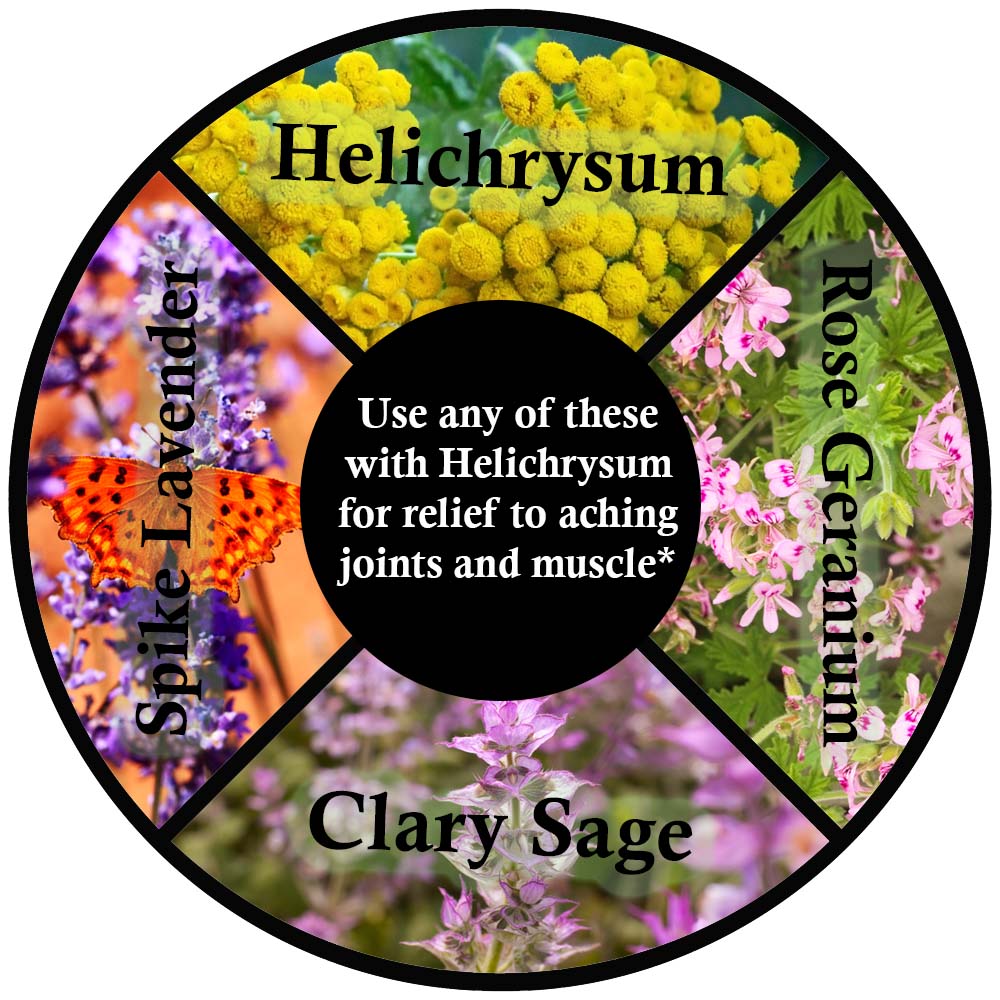 |  | 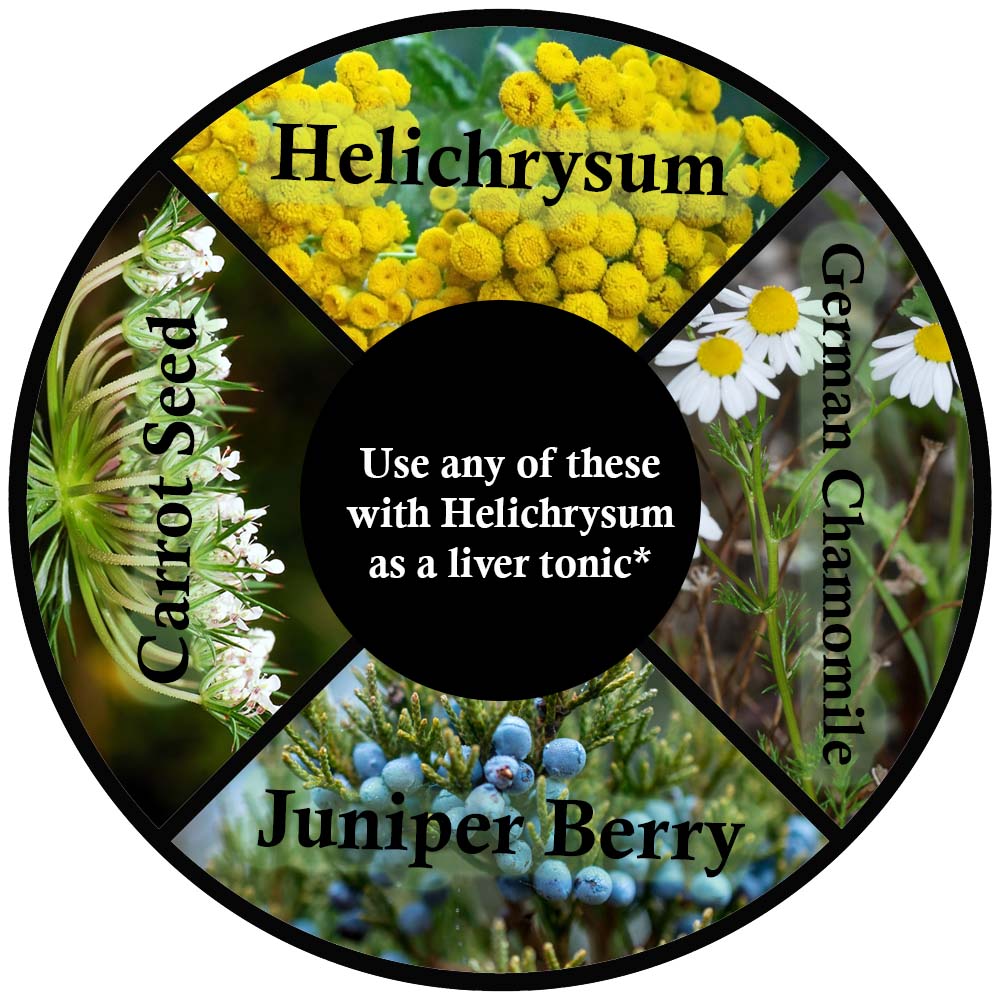 |
Final Thoughts from Dr. Streicher and Amrita’s Experts
We sincerely hope that you welcome this treasured, timeless essential oil into your personal apothecary. Helichrysum is a key component of skincare remedies, and it also relieves pain, supports detoxification and enhances well-being.* When you use the age-old botanical wisdom of Helichrysum, supported by modern research, you and your loved ones will experience genuine healing!*
Happy Blending!
*These statements have not been evaluated by the Food and Drug Administration. These products are not intended to diagnose, treat, cure, or prevent any disease.

